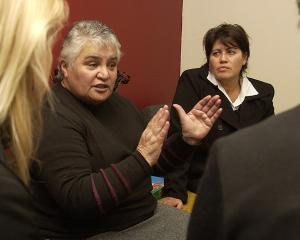
British sleep specialist Dr Kat Lederle said some people did not mind what position they slept in, while others had a preferred position but that could also change over time.
‘‘But I think one that a lot of people like is sleeping on the side, then I think some people like sleeping on their front and then we’ve got the back sleepers.’’

‘‘That’s predominantly for those who are lying on their front - the head either goes to the left or to the right and that puts quite some tension on the neck.’’
The other related to breathing difficulties, for example sleep apnoea could be aggravated by sleeping on your back.
For those who got shoulder pain as a result of sleeping on their side, special pillows were available to place between the knees in order ‘‘to try and keep everything in alignment and thereby reduce pressure perhaps on the shoulder’’.
People who suffered from neck pain may benefit from using a flatter pillow, she said.
‘‘I’m thinking there of alignment of the neck, of the spine, of the hip, that it’s all on one level, or as much as you can get it on one level. I would avoid having a thick big pillow because then you actually put some strain on your neck.’’
It might not be a good idea to sleep the entire night on your stomach as that could lead to neck pain and potentially stomach issues such as acid reflux.
People who had some type of pain during the day can be restless sleepers.
‘‘There is something about trying to find a comfortable position and often if there’s chronic back pain no position is perfect for the entire night, so there’s a lot of sort of restlessness, a lot of shifting and tossing and turning.’’
The person was not necessarily completely awake, but that type of restless sleep meant they probably got less restorative deep sleep, she said.
That could lead to a vicious cycle.
‘‘You haven’t slept so very well because of pain but then not having slept well we know we’re more sensitive to pain so then you’ve got another painful day ahead of you followed by probably a painful night.’’
Pregnancy could also disrupt sleep due to discomfort and it seemed to be more helpful for pregnant people to sleep on their left side, she said.
‘‘That sort of can release tension and pressure and generally support their wellbeing and the baby’s wellbeing.’’
It was recommended that anyone who suffered from acid reflux also slept on their left side.
But although it was worth being informed about different sleeping positions and their potential benefits and hazards, there were no hard and fast rules about what position people should sleep in.
It was important ‘‘not to get too hung up and stressed about it because that can actually then lead to poor sleep‘‘, she said.
There was no-one-size-fits-all in terms of mattresses, duvets and pillows.
That was because everyone had different body shapes and preferences.
If possible, people should trial a mattress to find out if it was right for them before buying.
‘‘That is sort of the little niggle or problem I sometimes have when there is one product that’s being advertised as the sleep solution for every single person on this planet, it’s just not true.
‘‘Unfortunately, we have to all find what is working for me at this moment in my life.’’













